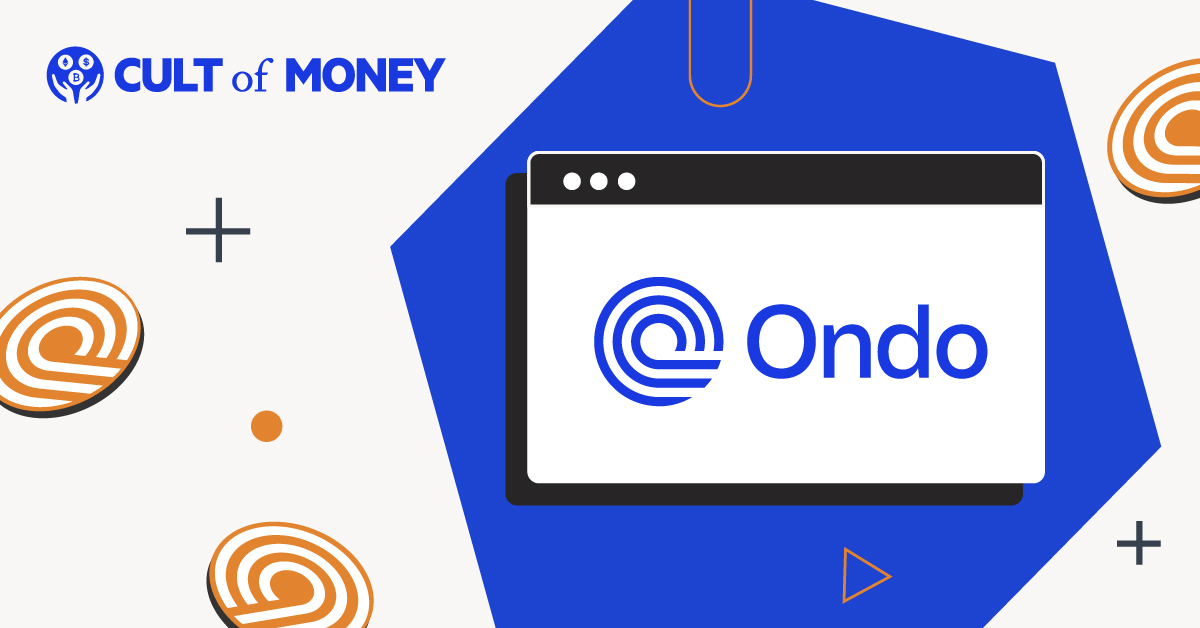
Access to investment-grade, institutional financial products can be difficult on the blockchain. However, some companies have started tokenizing more traditional assets — like stocks and bonds — and allowing on-chain purchases of these assets.
One such platform is Ondo Finance, which recently announced that it’s tokenizing U.S. Treasuries and other bonds. So, how does Ondo Finance work? And can you really take advantage of the current elevated Treasury and bond rates on the blockchain?
Let’s take a look at Ondo Finance and how you can use it to invest in tokenized bonds.
What is Ondo Finance?
Ondo Finance is a decentralized finance (DeFi) platform that specializes in providing access to tokenized investments. The stated goal of Ondo Finance is to make it possible for people to access institutional assets — like bond funds managed by prestigious asset managers — via the blockchain.
The company was founded in 2021 and has its headquarters in New York. Ondo Finance has received three rounds of funding:
Seed round in August 2021
Series A in April 2022
Initial coin offering in July 2022
Investors in Ondo Finance include well-known entities like Pantera Capital and Tiger Global Management. Through partnerships with recognized companies like BlackRock and Coinbase, Ondo Finance seeks to show that it is a viable and reputable way to use the blockchain to invest in more traditional assets.
What Does Ondo Finance Offer?
Currently, Ondo Finance focuses mainly on high-quality bond exchange-traded funds (ETFs). These are ETFs that have been tokenized and are available on the blockchain through the Ondo Finance platform.
Ondo Capital Management is a company that oversees the management of its funds. It is a subsidiary of Ondo Finance, which develops software for DeFi protocols. The fund offerings include:
Ondo Short-Term U.S. Government Bond Fund (OUSG): Focuses on U.S. Treasuries with shorter maturities. It’s considered relatively safe because the ETF tracks the performance of U.S. government bonds, which are considered some of the most stable assets in the world. This fund has a rating of AAA.
Ondo Short-Term Investment Grade Bond Fund (OSTB): This ETF includes exposure to a variety of bonds that are still considered investment grade, although not considered as safe as U.S. government bonds. This fund has a rating of BBB-.
Ondo High-Yield Corporate Bond Fund (OHYG): With the highest potential returns, this ETF also comes with the highest amount of risk. You gain exposure to an ETF that tracks high-yield corporate bonds. This fund has a rating of BB-, which makes it speculative grade, rather than investment grade.
There is also a low-yield “Compound” account that allows you to earn a return from eligible stablecoins. However, this account has a much lower potential return and a lower B- rating, which makes it the riskiest of assets available on Ondo Finance.
How Does Ondo Finance Work?
Shares in the assets offered by Ondo Finance are tokenized and represented by the tickers. They are all held in separate sub-accounts at the appropriate custodians. In order to participate, you basically contribute to a limited partnership registered in Delaware. You also subscribed to your desired fund.
You also need to connect an Ethereum-compatible wallet, since you’ll accomplish your business using U.S. Dollar Coin (USDC). Before you can start, though, you’ll need to be verified. Ondo Finance requires that you go through “Know Your Customer” (KYC) and “Anti Money Laundering (AML) verification before participation. Basically, Ondo Finance doesn’t want to run afoul of regulation by offering securities to non-verified participants.
The process of actually investing in a tokenized asset is a big involved, since it includes various third parties that act as custodians and facilitators for different aspects of the investment. Here is a basic overview of how the process works:
Go through the process of becoming whitelisted and connecting your compatible wallet.
Send USDC to the desired fund’s smart contract, at which point, your USDC will be transferred to Coinbase Custody.
Coinbase handles the process of converting your USDC to U.S. dollars that can be sent to a partner bank’s Clear Street account. Clear Street is the custodian that is responsible for holding off-chain assets associated with the ETF, and that executes the off-chain portion of the process.
After confirming the transaction, you receive the appropriate token for the fund (OUSG, OSTB, or OHYG). The tokens you recieve represent your shares in the fund.
When a dividend is paid, the proceeds are used to purchase more shares in the fund — and you receive more tokens.
Redemption works similarly. You send a request to the smart contract, and the appropriate shares are sold at Clear Street. The proceeds (in U.S. dollars) are then converted to USDC at Coinbase. You then receive the USDC in your connected wallet. You can use the USDC in other places in the decentralized finance ecosystem or you can liquidate them into U.S. dollars and have the money deposited in your traditional bank account.
Ondo Finance offers the option to set up auto-selling to make it easier to maintain regular liquidity when it comes to the fund.
Ondo Finance Fees
First of all, Ondo Finance charges a management fee of 0.15% annually. However, there are additional fees associated with the specific ETF fund management. As of this writing, the ETF management fees, charged on top of the 0.15% fund management fee, include:
OUSG: 0.15% annually
OSTB: 0.35% annually
OHYG: 0.48% annually
There might be other fees charged by custodians, so it’s important to pay attention to your real returns. You could be paying more in fees than you expected.
How to Get Started with Ondo Finance
If you decide that Ondo Finance is the right move for you, it’s important to note that the minimum investment for all of Ondo Finances tokenized bond funds is 100,000 USDC.
Next, you need to be whitelisted as a qualified purchaser. A qualified purchases is someone who meets very specific criteria that includes having at least $5 million in invested assets, not including a primary residence or property used for business. A qualified purchaser can be an individual or a family-owned business.
It’s important to note that someone managing at least $25 million from all qualified purchasers can also be considered a qualified purchaser.
Basically, though, in order to start with Ondo Finance, you need to be able to meet the threshold of “qualified purchaser” and be willing to invest at least 100,000 USDC.
If you meet those requirements, you can go through the whitelisting process. You will need to provide government-issued documentation about your identity, as well as provide corroborating documents about your assets. After you’ve done this and your information has been reviewed, you’ll be whitelisted. From there, you can connect your compatible wallet and start the subscription process.
Is Ondo Finance Safe?
Any investment comes with risk. However, Ondo Finance tries to do its best to provide as much transparency and security as possible. Some of the ways Ondo Finance describes its security and trustworthiness include:
Custodians like BlackRock and Coinbase Custody, are generally respected.
Clear Street, one of Ondo Finance’s partners, has an account with the Depository Trust Company, which is the main way U.S. ETF transactions are settled.
Audits through trusted third parties are designed to verify the code and the process.
However, it’s important to note that tokens like those issued by Ondo Finance aren’t protected by SIPC insurance. If something happens to Ondo Finance, there’s no guarantee that you’ll be able to redeem your tokens for U.S. dollars or even USDC.
When deciding whether to invest in any asset — including tokenized assets using the blockchain — you need to consider your risk tolerance. Be careful of investing any money that you can’t afford to lose. Any type of investment related to the blockchain is still speculative. You don’t have the same protections that you’d see with more traditional assets, and the regulatory environment is still in flux, so there’s no knowing what’s next for tokenized securities.
Bottom Line: Should You Invest with Ondo Finance?
If you’re looking for a way to diversify your DeFi holdings and potentially see higher yields from assets that might be considered more stable, Ondo Finance might be a good choice — as long as you meet the requirements and have 100,000 USDC you’re willing to invest.
However, before you invest in tokenized U.S. Treasuries and bonds, make sure you understand the process and the risks. Remember that, even with the ratings on the underlying ETFs being tokenized, there’s no guarantee of a return. Carefully consider your portfolio goals and strategy before adding Ondo Finance products to your investment plan.

Miranda Marquit, MBA, has been covering personal finance, investing and business topics for more than 15 years, and covering crypto topics for more than 10 years. She has contributed to numerous outlets, including NPR, Marketwatch, U.S. News & World Report and HuffPost. She is an avid podcaster, co-hosting the podcast at Money Talks News. Miranda lives in Idaho, where she enjoys spending time with her son playing board games, travel and the outdoors.
